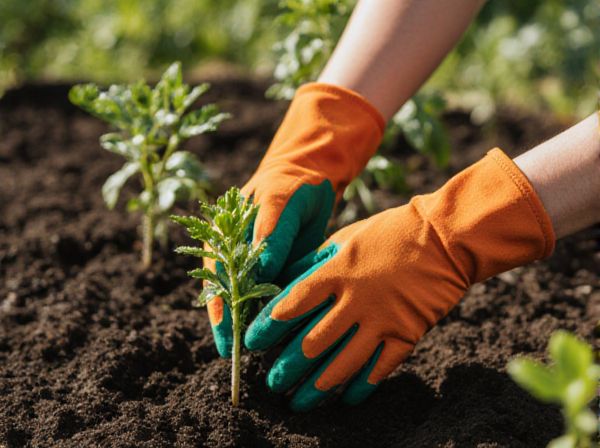
Polyculture planting vs monoculture planting Illustration
Polyculture planting enhances biodiversity by cultivating multiple crop species together, which improves soil health and reduces pest outbreaks naturally. In contrast, monoculture planting relies on a single crop type, often leading to soil depletion, increased vulnerability to pests, and higher dependency on chemical inputs. Embracing polyculture supports sustainable agriculture by promoting ecological balance and long-term productivity.
Table of Comparison
| Aspect | Polyculture Planting | Monoculture Planting |
|---|---|---|
| Biodiversity | High - multiple species cultivated simultaneously | Low - single crop variety cultivated |
| Soil Health | Improves soil fertility and structure through diverse root systems | Depletes soil nutrients; increases erosion risk |
| Pest & Disease Control | Natural resistance through species diversity | Increased vulnerability; often requires chemical pesticides |
| Yield Stability | More resilient to climate variability and pests | Higher short-term yield but less stable over time |
| Environmental Impact | Lower - promotes ecosystem balance and reduces chemical use | Higher - chemical dependency and habitat disruption |
| Management Complexity | More complex; requires diverse knowledge and planning | Less complex; standardized practices |
Understanding Polyculture and Monoculture in Permaculture
Polyculture planting in permaculture involves cultivating multiple plant species together to mimic natural ecosystems, enhancing biodiversity, soil health, and pest resistance. Monoculture planting, by contrast, focuses on a single crop species, often leading to soil depletion, increased vulnerability to pests, and reduced ecological balance. Understanding the benefits of polyculture highlights its role in sustainable agriculture by promoting resilience and productivity through diverse plant interactions.
Core Principles of Polyculture Planting
Polyculture planting involves cultivating multiple plant species together, enhancing biodiversity, soil health, and ecosystem resilience, which contrasts with monoculture's single-species focus that often depletes soil nutrients and increases pest vulnerability. Core principles of polyculture include species diversity for complementary nutrient use, natural pest control through habitat complexity, and improved resource utilization by layering plants with varying root depths and growth habits. This approach supports sustainable agroecosystems by mimicking natural ecosystems, promoting long-term productivity and environmental balance.
Key Characteristics of Monoculture Systems
Monoculture planting involves cultivating a single crop species over a large area, which simplifies management but often leads to decreased biodiversity and increased vulnerability to pests and diseases. This system typically relies heavily on synthetic fertilizers and pesticides to maintain high yields, contributing to soil degradation and environmental pollution. Monoculture's focus on uniformity contrasts sharply with polyculture's diverse plant assemblages that promote ecosystem resilience and sustainability.
Biodiversity Benefits in Polyculture Gardens
Polyculture planting enhances biodiversity by cultivating multiple plant species simultaneously, creating a resilient ecosystem that supports diverse beneficial insects, birds, and soil microorganisms. This diversity reduces pest outbreaks and disease spread, promoting natural pest control and soil health compared to monoculture systems that rely on single crops and often require chemical inputs. Increased biodiversity in polyculture gardens strengthens ecosystem stability, improves nutrient cycling, and fosters sustainable agricultural practices.
Soil Health: Polyculture vs Monoculture Impact
Polyculture planting enhances soil health by increasing biodiversity, which promotes nutrient cycling and reduces pest outbreaks, leading to improved soil structure and fertility. Monoculture planting depletes specific nutrients, diminishes microbial diversity, and increases vulnerability to diseases, resulting in soil degradation over time. Sustainable permaculture relies on polyculture systems to maintain resilient ecosystems and long-term soil productivity.
Pest and Disease Management Comparison
Polyculture planting enhances pest and disease management by promoting biodiversity, which disrupts pest habitats and encourages natural predator populations, reducing the need for chemical interventions. In contrast, monoculture planting often leads to pest outbreaks and disease spread due to uniform crop vulnerability and continuous availability of host plants. Integrating diverse plant species in permaculture systems fosters ecological balance and resilience against pests and diseases.
Yield and Productivity: Which System Performs Better?
Polyculture planting enhances yield and productivity by promoting biodiversity, which improves soil health and pest resistance, leading to more stable and higher overall outputs compared to monoculture systems. Monoculture planting may produce high yields for a single crop in the short term but often suffers from nutrient depletion and increased vulnerability to pests, resulting in lower long-term productivity. Studies show that polyculture systems deliver greater aggregate yields per unit area by optimizing resource use and reducing environmental stressors.
Sustainability and Resilience in Planting Practices
Polyculture planting enhances sustainability by promoting biodiversity, which improves soil health and reduces pest outbreaks without chemical inputs. This diversity fosters ecological resilience, enabling the ecosystem to better adapt to environmental stresses such as drought or disease. In contrast, monoculture planting often depletes soil nutrients and increases vulnerability to pests, compromising long-term productivity and ecosystem stability.
Real-World Examples of Polyculture Success
Polyculture planting systems demonstrate significant ecological and economic benefits compared to monoculture, as seen in the traditional milpa system of Mexico where maize, beans, and squash are cultivated together, enhancing soil fertility and reducing pest outbreaks. The rice-fish farming approach in Southeast Asia exemplifies polyculture by integrating fish into rice paddies, improving water quality and increasing overall yield by providing both grain and protein sources. These real-world examples highlight polyculture's ability to create resilient agricultural ecosystems that sustain biodiversity and improve food security.
Transitioning from Monoculture to Polyculture in Your Garden
Transitioning from monoculture to polyculture in your garden enhances soil health by diversifying plant species, which increases nutrient cycling and reduces pest pressures naturally. Incorporating complementary plants like legumes, herbs, and vegetables creates a resilient ecosystem that supports beneficial insects and improves microclimate conditions. Gradual integration of polyculture plots allows adaptation to changing soil dynamics and maximizes yield sustainability over time.
Polyculture planting vs monoculture planting Infographic

 gardendif.com
gardendif.com